Raised bed gardens have become so popular over the last 10-20 years, mainly because you can literally garden anywhere there is space enough for a pot or small raised bed: the backyard, front yards, patios, and even rooftops are all able to be turned into lush gardens using raised beds made out of wood and other planter materials.
But what kind of garden soil mixture do you fill your raised beds with?
Many gardeners have found that something called “Mel’s Mix” is a great option, especially if you’re building your first raised bed. It combines all the high nutrients soil types with well-draining organic material that make it an excellent soil for growing a bumper crop in your raised beds.
What is Mel’s Mix
Mel’s mix is a mixture of soil types that is commonly used in a gardening method known as square foot gardening. The concept of square foot gardening was created by a man named Mel Bartholomew (get it? Mel’s mix) in the bestselling book he wrote about it. But he also created this formula or recipe for creating soil that plants THRIVE in.
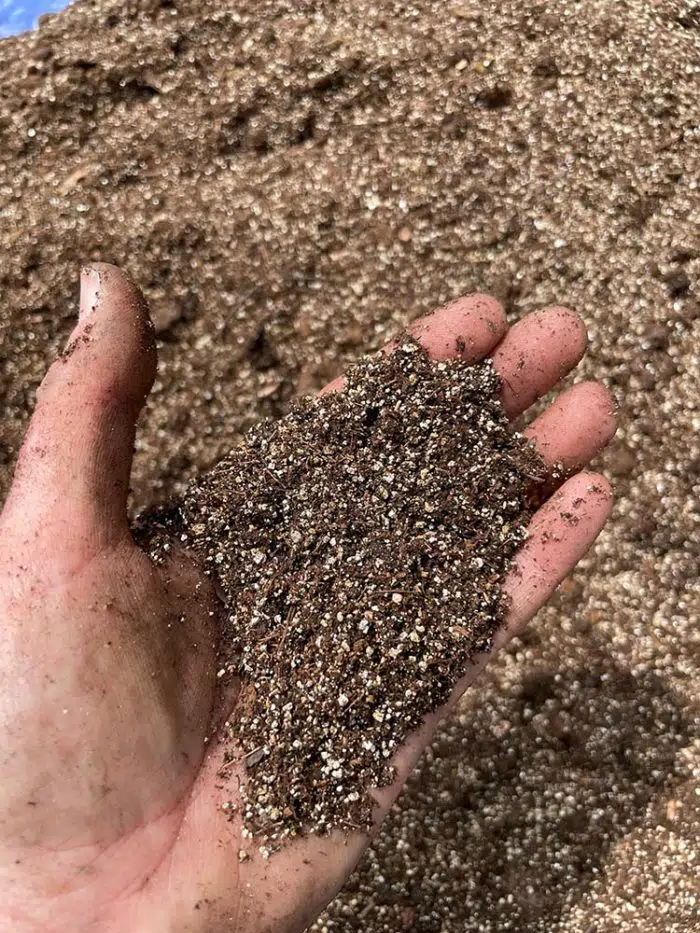
Mel’s mix is made up of 3 ingredients and is great for filling up raised beds and getting a robust harvest out of your garden. If you’re new to raised bed gardening, this is the stuff to use because it’s a tried and true method that will make it much harder to kill your plants. 😉
Upfront, Mel’s mix can be a little price intensive, but over the years, compost is the only ingredient you’ll need to replenish as the other two don’t break down quickly.
Mels Mix Recipe
You can make “Mel’s mix” by combining equal parts (by volume, not weight) of:
- Compost
- Coarse vermiculite
- Peat Moss
There are very methodical reasons Mel used these 3, so let’s take a closer look.
1. Compost
Compost is a highly concentrated organic matter that can be made up of all kinds of things. It’s where you’ll get the food and nutrients for your plants.
Most commonly, compost has come to be known as the breakdown of food scraps, grass clippings, leaves, sticks, and other yard waste. But there are a few varieties as well.
Can You Use Just Any Compost?
If you don’t have your own compost bin, you can buy some at a local garden center or nursery. In the official Mel’s mix recipe, you’re supposed to buy 4-5 different types of compost and combine them.
Why buy multiple kinds of compost? Because you want the biodiversity that each brings. Cow manure is great, but you don’t want ALL cow manure.
Each type of compost is awesome on its own, but mixed together it’s even more robust.
Here are some types of compost/manure you can choose from:
- Chicken manure
- Poultry manure
- Dairy manure
- Mushroom compost
- Wood blend
- Worm Castings
- Seaweed compost
- Leaf mold
- Homemade compost
Try to shop local and go to your garden center or local nursery first. Home Depot, Tractor Supply, or Lowes will likely only have one type of bagged compost which won’t introduce as much biodiversity or nutrients into your plant’s ecosystem.
There are often nearby places where you can buy bulk compost and save a bit of money – especially since you’ll likely need quite a bit of it.
Once you have that blended compost mix, you’ve officially done the hard part 🙂
2. Peat Moss
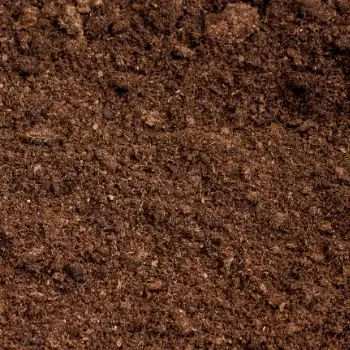
Peat moss is the second ingredient in Mel’s mix. Peat moss is great for retaining water and keeps the soil loose and is great for the roots to dig down deep.
Now, some people are going to point out that peat moss is not sustainable and say you should use coconut coir instead. And that is an option to make sure you’re getting a similar substance that retains water as well.
When you buy it, it will be compressed into big blocks, so you’ll need to open the bag, and mix it around so it gets more fluffy. Once it’s broken down, you’ll want to use that for your Mel’s mix.
Coco Coir as an Alternative
While peat moss has unique qualities that are perfect for this mix, coconut coir is seen as a great alternative if you’re unable to get your hands on peat moss. It’s a byproduct of the coconut industry, so it’s seen as slightly more sustainable since we’re using something that would otherwise be thrown away.
3. Vermiculite
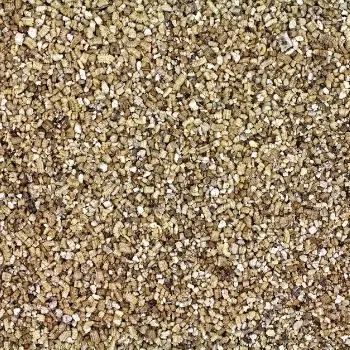
Vermiculite is a rocky material that is going to help your plants from drying out. It comes from the ground and is broken down into smaller pieces to use in the garden.
These rocks retain water really well, and so combined with peat moss it’s a great addition to this soil mix.
Using vermiculite will help make the soil more fluffy as well, allowing roots to easily move around and get established. This also makes it easier to weed because the weed roots will come right out, as opposed to hard native soil in the ground that holds the roots quite well.
Special shoutout to my clay soil for making sure those weeds stay in the ground.
When you’re looking to buy vermiculite, make sure to look for “coarse vermiculite”, as it does come in much finer pieces as well.
Can You Use Perlite Instead?
You can use perlite in your Mel’s mix instead of vermiculite. It doesn’t hold water quite as well but for this application, it should work just fine. If perlite is all you can afford or you have some laying around, use that!
Mel’s Mix Calculations
Figuring out how much of this soil mixture you need to fill your raised beds can be tricky. And then on top of that, you have to break that number into 3 parts to determine how much of each ingredient you’ll need.
You can find how much you’ll need by doing some simple math.
Length x width x height
For example, if your bed is 4 feet by 4 feet and 6 inches tall you just take:
4 x 4 x 0.5 (because it’s half a foot tall) = 8 cubic feet
Once you have the total number, just divide that number by 3 and that’s how much of each ingredient you’ll need to get.
How Much Soil Do You Need?
Here are some common raised bed dimensions and the total amount of Mel’s soil mix you’ll need to fill your bed.
*These are all calculated for 6 inches of Mel’s mix, if you want more, double that number.
| Length | Width | Total Needed | Amount of Each Ingredient | |
| 3×4 foot bed | 3 feet | 4 feet | 6 cubic feet | 2 cu. feet |
| 4×4 foot bed | 4 feet | 4 feet | 8 cubic feet | 2.67 cu. feet |
| 4×6 foot bed | 4 feet | 6 feet | 12 cubic feet | 4 cu. feet |
| 4×8 foot bed | 4 feet | 8 feet | 16 cubic feet | 5.34 cu. feet |
| 4×10 foot bed | 4 feet | 10 feet | 20 cubic feet | 6.67 cu. feet |
Tall Raised Beds
You only need about 6-8 inches of this soil mix for your plants to grow into, so if you are using a tall raised bed there are some options. You might want to fill up the bottom of it with other ingredients so you aren’t spending an arm and a leg to fill up the entire bed with Mel’s mix.
Some ideas for filling up the bottom of your raised bed are: wood chips, stumps, leaf mold, cardboard, or any kind of natural filler. You can also use some version of the lasagna gardening Mel mentions in the book as well.
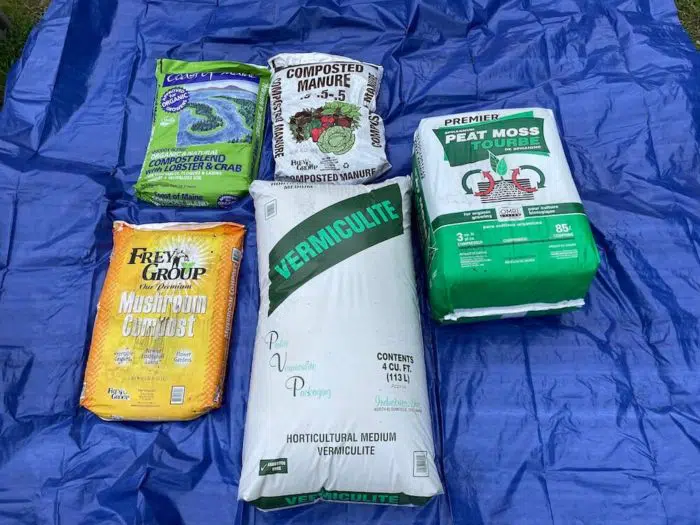
How to Mix Together Mel’s Mix
That is a LOT of soil and materials to try and mix together, how in the world do you do this the right way?
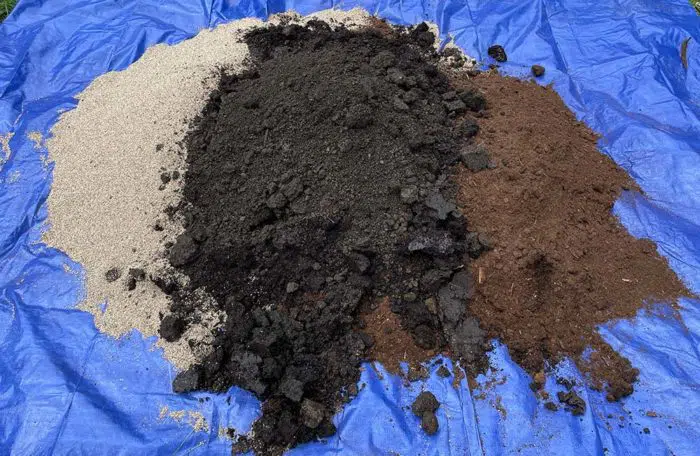
It’s much easier than it sounds. All you need is a tarp and an extra set of hands if possible.
- Put the 3 components (compost, vermiculite, and peat moss) on a tarp near your raised bed.
- Fold one side of the tarp over towards the other side.
- Repeat on the other side until it mixes well
If you don’t have a tarp, you can use a baby pool or large container to mix it around.
If you don’t have another person around to help you, it’s much easier to do it in batches. I also used a mini-shovel and small pitchfork to help mix it around.
Note: this is much easier if you have at least 2 people to help mix it up and move it into the raised bed.
Advantages to Mel’s Mix
People swear by this soil mix because it produces such great results. It doesn’t incorporate artificial fertilizers or chemicals since you’re using natural ingredients.
In addition, Mel’s mix offers:
- Great drainage, which most vegetables love
- More acidic soil mix which is great for plants like potatoes
- Over time, you’re amending the soil below your raised bed with these nutrients breaking down into it
- Water retention properties of the vermiculite and peat moss means your beds won’t dry out as frequently.
- It’s almost impossible to overwater, because while it retains water, it only retains what it needs and the rest drains off.
Making Mel’s mix can seem expensive, and while the cost up front to create Mel’s mix is higher, over the years you only need to add more compost as the coarse vermiculite and peat moss will break down more slowly.
Can’t I Just Use Potting Soil?
Of course, you can use potting soil or regular garden soil in your raised bed garden. But it’s not going to have anywhere near the nutrients or organic fertilizer your plants get from this “perfect soil mix”.
It’s a way to keep your vegetables healthy, growing large, and feed yourself and your family (or your neighbors if you go a little overboard like I do! ha!).


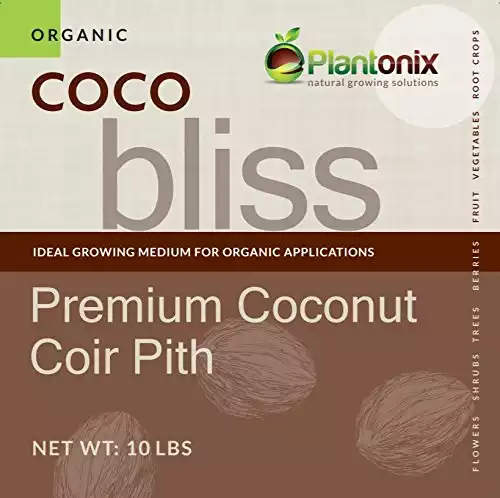
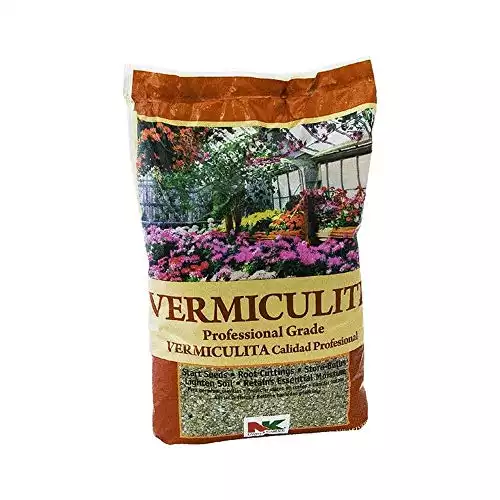

Thanks. This was exactly what I needed to know today — how to calculate how much of each ingredient to buy.
You’re welcome! 🙂 I’m glad adding those examples in there was helpful.
After having Mels soil in raised beds for 5-10 years and the soil becomes tightEr Again ( even though I added coarse sand to his mixture) is there anything more That needs to be done now to bring it back to the first made mixture?
Hey Bon! I would try mixing some compost or shredded leaf mulch into the Mel’s mix. This should help introduce organisms that will help loosen the soil and add more nutrients back in.
Thanks so much for this great info. So if I understand correctly if I have my own home made compost I would use that as the total need for compost, but if I have to buy it I should use 4-5 different varieties? Also if I have my own fresh worm casting how much should I add to my home made compost? Maybe 1 part castings and 3 part home made compost, or is 1/2 and 1/2 ok?
Your worm castings would count as one part of the 4-5 varieties of compost – whatever that works out to be. So it could be one third purchased compost, one third homemade compost, and one third worm castings.
WHERE TO BUY BAGS OF MELS MIX AND HOW TO USE IT
Hi Lois, Mel’s mix isn’t a brand, it’s more of a method for creating very productive soil. You can buy all the ingredients (listed above) and then you can mix them together in your garden beds.
Can I add Mel’s Mix to soil I already have in my raised bed from last summer? I’d hate to dump everything out and start all over.
Absolutely! I would just layer it on top of what’s already there. As long as all of the ingredients get added, you should do well!
Hi,
Loved your article. I wish I would have found it earlier.
I couldn’t spend over $200.00+ on 4-4cf. vermiculite bags for 6 – 4 x 4 beds.
I was able to buy enough peat and compost throughout the winter with my budget, and only 3 – 4cf. bags of vermiculite. My concern is I will be short on the vermiculite. I am hoping the mix will still work without the exact amount. I actually might be a bit heavy on the peat. Will this create problems? Your thought? I may be able to increase the vermiculite next year.
I hear you, it can be an expensive up front cost. If I were you, I’d put the right ratios in however many beds you can, and then next year buy some more vermiculite for the other beds if you find it’s not working as well as the ones with the “right” mix.
The compost is one of the more important pieces in my mind because of the nutrients it provides. Make sure your beds are getting enough water, especially on those hot days as vermiculite is great as a water retention ingredient so the beds with and without it might behave differently.
We tried Mels mix for the first time this spring in our stock tanks. We went to three different nurseries, all well known in our area, and all three only had black kow compost so we only used one type of compost. I’m not sure where others are finding more than one type of compost. None of our plants, seedlings or transplants bought at nurseries, were doing well until I added a supplemental fertilizer. I’m not ready to say I think the expense was worth it.
I have found that when I stray from his recommendations I regret it. I’ve been doing SFG for over 20 years. Our Lowe’s and Home Depot and all of our nurseries have different types of compost but the good nurseries def have a better variety. EVERY time I bought the cheaper compost blend at Lowe’s my garden struggles. It’s not usually broken down enough. Too many big chunks stealing nitrogen from the soil. Also, a lot of people have been complaining about manure being contaminated with Graizon (something like that) and entire gardens being destroyed. I think I’ll stick to Happy Frog Soil Conditioner from now on!